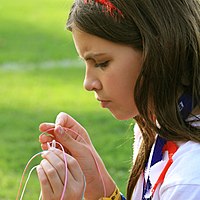
Photo from wikipedia
PURPOSE To determine optimum flow settings on the Centurion Vision System during the grooving step in cataract surgery. SETTING John A. Moran Eye Center Laboratory, University of Utah, Salt Lake… Click to show full abstract
PURPOSE To determine optimum flow settings on the Centurion Vision System during the grooving step in cataract surgery. SETTING John A. Moran Eye Center Laboratory, University of Utah, Salt Lake City, Utah, USA. DESIGN Experimental study. METHODS Intact porcine lenses hardened by formalin and placed in a chamber designed to simulate the anterior chamber of the eye were used to test flow rate settings at 20 mL/min, 40 mL/min, and 60 mL/min. Vacuum was set at 400 mm Hg, longitudinal power at 80%, torsional power at 80%, and intraocular pressure at 50 mm Hg. A balanced phaco tip with a 20-degree tip and a 30-degree bevel was used. Efficiency (time to groove the lens in half) was determined. RESULTS Increasing flow from 20 to 40 mL/min during grooving increased efficiency by 17% (P = .05), with no significant improvement shown at 60 mL/min. CONCLUSIONS A flow rate of 40 mL/min was determined to be most efficient during the grooving step of cataract surgery. Further increases in flow rate showed no statistically significant improvement in efficiency, and with only 17% improvement flow rates less than 40 mL/min might be almost as efficient and might be safer.
Journal Title: Journal of cataract and refractive surgery
Year Published: 2018
Link to full text (if available)
Share on Social Media: Sign Up to like & get
recommendations!